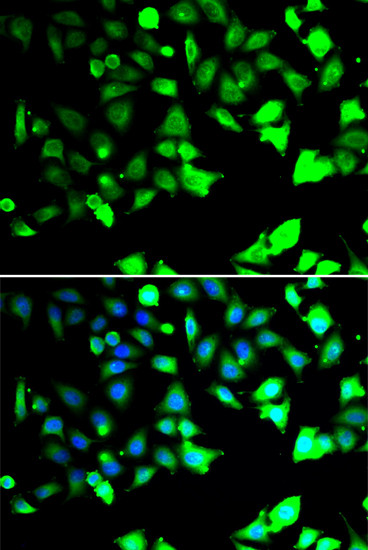Product Details
PA5-89130
Species Reactivity
Host/Isotype
Class
Type
Immunogen
Conjugate
Form
Concentration
Purification
Storage buffer
Contains
Storage conditions
Shipping conditions
RRID
Product Specific Information
Immunogen sequence: MTFNSFEGSK TCVPADINKE EEFVEEFNRL KTFANFPSGS PVSASTLARA GFLYTGEGDT VRCFSCHAAV DRWQYGDSAV GRHRKVSPNC RFINGFYLEN SATQSTNSGI QNGQYKVENY LGSRDHFALD RPSETHADYL LRTGQVVDIS DTIYPRNPAM YSEEARLKSF QNWPDYAHLT PRELASAGLY YTGIGDQVQC; Positive Samples: SW620, Mouse lung; Cellular Location: Cytoplasm, Nucleus
Target Information
ATP synthase is extremely conserved through evolution and can be found in plants, fungi, bacteria, and animals. The ATP synthase enzyme is a transmembrane protein responsible for driving the reversible reaction from ADP+ phosphate to ATP. This reaction is accomplished by a flux of protons across the membrane as a result of electron transfer. The ATP synthase protein has two main sections; the F1 ATP-ase (soluble) and the F0 ATP-ase (membrane embedded). The F1 section consists of the alpha, beta, gamma, delta, and epsilon subunits. While the F0 consists of a, b, and c subunits.
For Research Use Only. Not for use in diagnostic procedures. Not for resale without express authorization.
References (0)
Bioinformatics
Protein Aliases: Baculoviral IAP repeat-containing protein 4; BIR4; E3 ubiquitin-protein ligase XIAP; HILP; IAP-3; IAP-like protein; ILP; Inhibitor of apoptosis protein 3; RING-type E3 ubiquitin transferase XIAP; RP1-315G1.5; X-linked IAP; X-linked inhibitor of apoptosis protein; X-linked inhibitor of apoptosis, E3 ubiquitin protein ligase
Gene Aliases: API3; BIRC4; hIAP-3; hIAP3; IAP-3; IAP3; ILP1; MIHA; XIAP; XLP2
UniProt ID: (Human) P98170
Entrez Gene ID: (Human) 331

Performance Guarantee
If an Invitrogen™ antibody doesn't perform as described on our website or datasheet,we'll replace the product at no cost to you, or provide you with a credit for a future purchase.*
Learn more
We're here to help
Get expert recommendations for common problems or connect directly with an on staff expert for technical assistance related to applications, equipment and general product use.
Contact tech support

